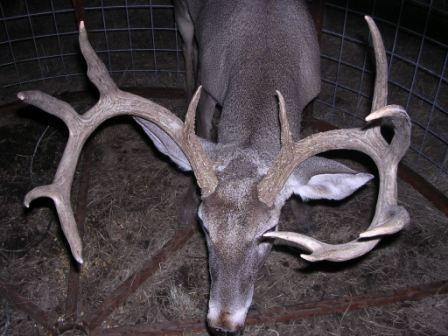
Trapping deer can indeed occur accidentally. Very few people actually attempt to catch deer because in just about every instance, to attempt to catch, capture, or even posses a wild white-tailed deer requires some sort of state permit. However, more whitetails are captured in some sort of trap than we probably realize. However, I imagine and hope most are not fatal.
Typically, deer are captured as non-target species while hunters and trappers attempt to catch feral hogs or control predators such a coyotes. The white-tailed buck pictured here was inadvertantly trapped in a hog trap. The use of regular whole-kernal corn in hog traps is very effective at catching deer, so the necessary steps should be taken when using hog traps to avoid capturing deer.
Several precautions one can take when trapping hogs is to use soured corn, milo, rice, or other grain. The sour smell is attractive to wild hogs, but whitetail deer will avoid the smell and trap altogether. Deer do not like soured grains or acorns.
Make sure the doorway or entry to traps are built such that deer are discouraged from entering. Otherwise, make traps such as this with open tops so that “trapped” deer can escape by jumping out.
Another way deer can be wrongly captured is with the use of snares. Many people will use snares in an attempt to captured wild dogs or coyotes, but deer will sometimes use the same trails and fence crossings as these animals. Take caution when setting out snares because deer and other non-target species could end up in them. It would be a shame to take the biggest buck you ever layed eyes on in a snare!
If you do happen to catch a deer in a trap, the best way to get it out is to wait until dark and approach with a flashlight. Blind the deer with the light, open the door, and get the heck out of the way!




